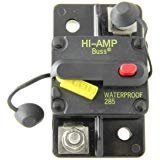Okay... given that, then my
impression -and again, let me reiterate that permanent installations are
not my forte, as their requirements are significantly different than mobile installations, so I'm definitely not the expert for this application- is that the proper grounding method would be to tie all panel frames together with through-frame grounding clamps and copper wire and run that down to a PE ground (literally a grounding rod pounded into the dirt with the wire clamped to it), then same on the controller and inverter side... take a copper wire from the chassis ground screws and run it outside to a PE ground. If you're not tying into your home electrical panel, then I would
not ground it to the same ground as the panel; I'd want to keep the two different electrical systems entirely isolated from one another.
I'd recommend the
MidNite Solar MNPV3 Solar Combiner Box for your application (given your stated 2s3p configuration). Note that's not a link to us - we don't carry those, but I reasonably trust Northern AZ Wind & Sun. A number of our customers have used them for other things and been happy with pricing/customer service/etc. In fact, it might be worth giving them a call and talking to them about your system, as they're far more familiar with home solar systems than I am.
By my understanding, however, you'd then run plastic conduit out of the combiner box with your (now) 1 POS and 1 NEG DC cable inside, presumably burying the conduit, over to your solar controller which I assume would be mounted in your garage or something, and connect normally. I'd plan on burial just for protection of the cabling, but of course if you were rigging it up prior to permanent placement you could just lay out the conduit in your yard. I'd personally really rather see the DC power wire in the plastic conduit, though... I know there's direct-burial cable available but I always prefer a rigid shell in case of FUBAR.






